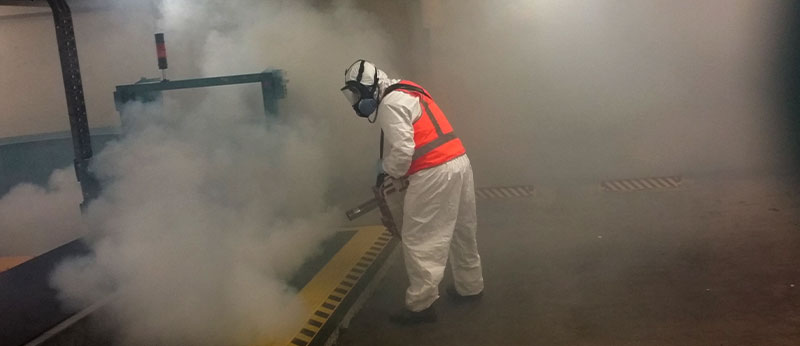Precision Biosecurity offers the right experience, the right equipment and the right antimicrobial treatment to get the job done.
The chemical being used by Precision Biosecurity is registered by the US EPA for the control of coronavirus.
This new generation product is a mixture of three dual chain quaternary ammonium active ingredients (listed below) that have a broad spectrum kill rate of microbial organisms.
Stage 1: Risk assessment
Site inspection
Our experienced technical staff will undertake a thorough site inspection and risk assessment. This includes:
1. Areas that need treatment
How ‘at risk’ are the areas of potential exposure to coronavirus? These are likely to be the high traffic areas where people with potential outside contact and exposure enter your workplace or facilities.
2. Safety risk to facilities
Electrical equipment, air-conditioning and fire alarms all need to be considered:
- All electrical items turned off and unplugged.
- All fire systems deactivated (this may be an issue for some facilities, but can be managed).
- All air-conditioning turned off.
3. Security
Our experienced operators will secure the treatment area for the duration of the treatment and post-treatment period before allowing public access:
- All members of the public excluded from treatment area (notices and barricades).
Stage 2: Treatment plan
Once a risk profile is established a treatment plan is developed.
This treatment plan is then enacted.
Whilst there are no legal claims for products specific for coronavirus control in Australia, the US EPA has released a list of antimicrobial products for use against the novel coronavirus virus SARS-CoV-2 (COVID-19), the cause of coronavirus.
The active ingredients in our treatment product, which is US EPA-approved, provides broad spectrum microbial control using three compounds or active ingredients:
- Octyl decyl dimethyl ammonium chloride
- Dioctyl dimethyl ammonium chloride
- Didecyl dimethyl ammonium chloride.
Once applied, the chemical is left in place to air dry. Food preparation surfaces need to be cleaned and wiped down prior to being used.
Stage 3: Post-treatment evaluation
1. Treatment completed. Please note: Our treatment is based on a wet fog and as such the surfaces will be wet. The best result is to let all surfaces air dry (not to be wiped down).
2. Allow one to two hours post-treatment for all surfaces to dry.
3. All food preparation surfaces are cleaned and wiped down prior to use. All other surfaces left as is (once dry).
4. Final inspection by Precision Biosecurity staff who check and give approval to:
- Turn air-conditioning back on.
- Turn fire alarm systems back on.
- Provide an ‘all clear’ for public to return.
